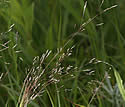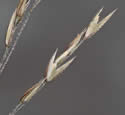Agrostis scabra (Rough Bentgrass)
| Also known as: | Ticklegrass |
|---|---|
| Genus: | Agrostis |
| Family: | Poaceae (Grass) |
| Life cycle: | perennial |
| Origin: | native |
| Habitat: | part shade, sun; wet to dry; prairies, wet meadows, swamps, bogs, swales, shores, forest openings, dunes, cliffs, rock outcrops |
| Fruiting season: | July - September |
| Plant height: | 8 to 36 inches |
| Wetland Indicator Status: | GP: FAC MW: FAC NCNE: FAC |
| MN county distribution (click map to enlarge): |  |
| National distribution (click map to enlarge): |  |
Pick an image for a larger view. See the glossary for icon descriptions.
Detailed Information
Flower: 

![[scan of panicle]](/udata/r9ndp23q/pd3/agrostis-scabra-15-s-t.jpg) Open panicle 4 to 10+ inches long, usually nearly as wide as long, lance to egg-shaped in outline, the main branches very slender, spreading to ascending, with appressed to slightly spreading branchlets mostly on the upper 1/3 of the branch. Sometimes the lowest branches are more erect, or partially hidden in the upper sheath. Spikelets (flower clusters) are single at branchlet tips, green or more often purple at flowering time, up to 3.4 mm (1/8 inch) long, and have a single floret.
Open panicle 4 to 10+ inches long, usually nearly as wide as long, lance to egg-shaped in outline, the main branches very slender, spreading to ascending, with appressed to slightly spreading branchlets mostly on the upper 1/3 of the branch. Sometimes the lowest branches are more erect, or partially hidden in the upper sheath. Spikelets (flower clusters) are single at branchlet tips, green or more often purple at flowering time, up to 3.4 mm (1/8 inch) long, and have a single floret.
![[close-up of flowering spikelets]](/udata/r9ndp23q/pd3/agrostis-scabra-7316-s2-t.jpg) At the base of a spikelet is a pair of bracts (glumes) that are 1-veined, keeled, rough along the keel, pointed at the tip, the upper glume 1.8 to 3.4 mm long, the lower glume somewhat shorter to about as long. Surrounding the floret is a pair of bracts (lemma and palea), the lemma thin, 5-veined, pointed to jagged to somewhat rounded at the tip, 1.4 to 2 mm long, shorter than the glumes, and rarely with a short, slender awn arising from the middle of the back; the palea is minute (less than .2 mm long) or more often absent altogether. The thickened base of the floret (callus) is sparsely covered in hairs .1 to .2 mm long.
At the base of a spikelet is a pair of bracts (glumes) that are 1-veined, keeled, rough along the keel, pointed at the tip, the upper glume 1.8 to 3.4 mm long, the lower glume somewhat shorter to about as long. Surrounding the floret is a pair of bracts (lemma and palea), the lemma thin, 5-veined, pointed to jagged to somewhat rounded at the tip, 1.4 to 2 mm long, shorter than the glumes, and rarely with a short, slender awn arising from the middle of the back; the palea is minute (less than .2 mm long) or more often absent altogether. The thickened base of the floret (callus) is sparsely covered in hairs .1 to .2 mm long.
Leaves and stems: 


![[photo of sheath and ligule]](/udata/r9ndp23q/pd3/agrostis-scabra-7316-s6-t.jpg) Leaves are mostly basal with 1 to 3 alternate stem leaves, all 1 to 3 mm (to ~1/8 inch) wide and hairless. Basal leaves are up to 5½ inches long and mostly rolled along the edges (involute); stem leaves tend to be flatter and shorter. Sheaths are hairless and mostly smooth. The ligule (membrane where the leaf joins the sheath) is 1 to 5 mm long, the top edge blunt to rounded and lacks a fringe of hairs. Nodes are smooth. Stems are erect to ascending, smooth, unbranched, multiple from the base forming clumps.
Leaves are mostly basal with 1 to 3 alternate stem leaves, all 1 to 3 mm (to ~1/8 inch) wide and hairless. Basal leaves are up to 5½ inches long and mostly rolled along the edges (involute); stem leaves tend to be flatter and shorter. Sheaths are hairless and mostly smooth. The ligule (membrane where the leaf joins the sheath) is 1 to 5 mm long, the top edge blunt to rounded and lacks a fringe of hairs. Nodes are smooth. Stems are erect to ascending, smooth, unbranched, multiple from the base forming clumps.
Fruit: 
![[photo of immature florets]](/udata/r9ndp23q/pd3/agrostis-scabra-15-13-t.jpg) The entire panicle commonly breaks off at maturity, blowing away tumbleweed style. Spikelets are purple to pale brown when mature, the florets dropping away leaving the glumes behind persisting on the stalk. The grain is elliptic, .9 to 1.4 mm long.
The entire panicle commonly breaks off at maturity, blowing away tumbleweed style. Spikelets are purple to pale brown when mature, the florets dropping away leaving the glumes behind persisting on the stalk. The grain is elliptic, .9 to 1.4 mm long.
Notes:
Rough Bentgrass is common in a variety of habitats from dry prairies, dunes and rock outcrops to swamps and peat bogs to Oak woodlands and Jack pine stands, usually in sandy or rocky soil. It is recognized by the open, airy panicle of long spreading to ascending, wiry branches, the lower branches up to 12 cm (4¾ inches) long and sometimes more erect or partially concealed within the upper sheath, branchlets concentrated on the tip 1/3 or so of a branch; single-flowered spikelets at branchlet tips; glumes mostly unequal, 1.8 to 3.4 mm long; lemmas 1.4 to 2 mm long, usually unawned, rarely with a straight or bent awn arising from the middle of the back; paleas absent or less than ¼ as long as the lemma; a few short hairs on the callus. Leaves are 1 to 3 mm wide, mostly basal and rolled along the edge; the 1 to 3 stem leaves tend to be flatter. The entire panicle can detatch and blow away like a tumbleweed.
Rough Bentgrass most closely resembles Winter Bentgrass (Agrostis hyemalis), which has a similar panicle of long branches with a few spikelets concentrated at branch tips and lacks significant paleas, but is generally a smaller plant, leaves less than 1 mm wide, its panicle branchlets are shorter so spikelets are more crowded together, and spikelets are smaller, the glumes only 1 to 2 mm long and lemmas .8 to 1.2 mm long. Of the 5 Agrostis species known to be in Minnesota, A. gigantea and A. stolonifera both have paleas about half as long as the lemmas, where the others have paleas that are minute at best and more often lack them altogether (magnification recommended).
Native Plant Nurseries, Restoration and Landscaping Services ↓
More photos
 Rough Bentgrass plants
Rough Bentgrass plants Rough Bentgrass in a rock outcrop
Rough Bentgrass in a rock outcrop a cloud of pink in late June
a cloud of pink in late June late season panicle
late season panicle close-up of panicle branches
close-up of panicle branches
Photos by Peter M. Dziuk taken in Anoka and Dakota counties.
Comments
Have you seen this plant in Minnesota, or have any other comments about it?






